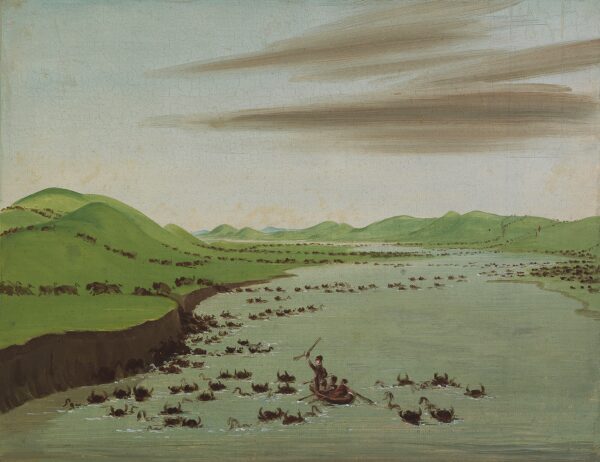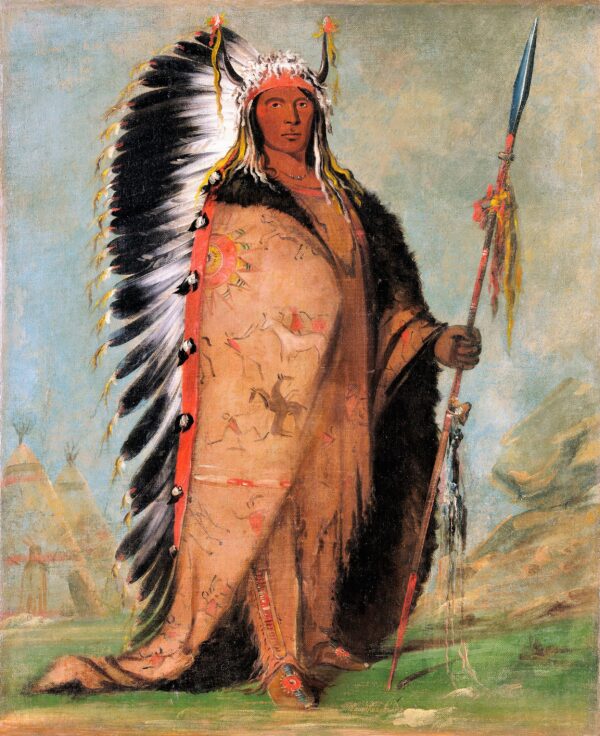Preserving and Teaching History through the Arts II
God created billions of animals to live in the Great Plains region of the United States. As many as five billion prairie dogs once lived in burrows beneath the Great Plains. The Corps of Discovery could hardly believe how many animals there were. On May 3, 1805, Corps co-leader William Clark wrote in his journal that they had seen “great numbers of buffalo, elk, deer, antelope, beaver, porcupines, and waterfowls, . . . such as geese, ducks of different kinds, and a few swans.” Clark wrote about buffalo and antelope, but the animals he and others called buffalo and antelope were actually bison and pronghorns. Native nations warned the Corps about how fierce grizzly bears were, but the Corps main leader Meriwether Lewis didn’t believe them until he tried to kill one himself.
The most important animal to the Plains nations was the bison. Millions of bison lived on the Great Plains. One herd could have 10,000 to 20,000 animals. In 1832 artist George Catlin painted the following scene of bison herds crossing the Missouri River. He wrote that they had heard the herds’ loud roaring several miles before he and his companions saw them. He described a wild scene of bison descending one side of the river, swimming across wildly while bumping into each other, and then climbing out on the other side. Catlin and his companions foolishly allowed their boat to get in the midst of the herd. In his painting, Catlin shows himself standing up in his canoe while yelling and gesturing to scare the bison away.

Buffalo Herds Crossing the Upper Missouri by George Catlin
Many nations hunted bison, especially nations who lived in the northern plains where crops did not grow as well. In the painting below, members of the Assiniboine Nation hunt bison while wearing snowshoes.

Assiniboine Indians Pursue Buffalo on Snowshoes by George Catlin
Before the Spanish brought horses to North America, men of the Plains nations hunted bison on foot, using bows and arrows. Some nations herded bison into a corral or off a cliff. Sometimes they wore disguises to do so.

Buffalo Hunt Under the White Wolf-skin Mask by George Catlin
Besides eating bison meat, Plains nations found dozens of ways to use the bison. They boiled the hooves to make glue. They made shields from bison humps. Some warriors wore bison horn armor over their chests. Hidatsa tied bison ribs together to make sleds. The Blackfoot strung bison teeth for necklaces. The Sioux wove thick ropes from bison tail fur and made spoons from their horns. They made rattles from bison hooves. They tied these rattles to doorways to signal that someone had entered their home. They also used the rattles in ceremonies.
Many nations made clothing and rugs from bison skin and fur. Most Plains nations wore bison moccasins. The Crow Nation left the fur on when they made winter moccasins. The Kansa Nation used bison they killed in summer for leather and bison they killed in winter for fur.
In the following portrait, the Sioux chief, Ee-áh-sá-pa, is wearing bison horns and a trailer warbonnet.

Ee-áh-sá-pa, Black Rock, a Two Kettle Chief (Sioux) by George Catlin
George Catlin painted Ee-áh-sá-pa at Fort Pierre, where he met fur traders and members of the Sioux Nation who were camped near the fort. Fur traders Mr. Laidlaw and Mr. McKenzie became very helpful to the artist. Catlin wrote about the day that he painted Ee-áh-sá-pa.
Catlin’s first portrait of a Sioux painted at the fort was of a head chief. Catlin finished this portrait before other Sioux knew that he was doing so. When Catlin finished the portrait, gathered Sioux were so fascinated by it that they insisted that he hang it outside of what Catlin called his “wigwam.” However, Sioux medicine men criticized the painting. They predicted that Sioux who had a portrait painted would have bad luck and even die prematurely.
The head chief whose portrait he had painted stepped forward to speak to the people. He told them to treat Catlin with friendship. He said that Catlin was a friend of Mr. Laidlaw and Mr. McKenzie. He said that Laidlaw and McKenzie had encouraged him to sit for the portrait. He told them there was no harm in having their portraits painted. Afterward, several hundred Sioux shook Catlin’s hand. Many got dressed up and came to have their portraits painted.
The next portrait Catlin painted was Ee-áh-sá-pa. Catlin described him as a fine looking man who was six feet tall or more. Catlin said that the horns he wore on his head showed that he was the head leader or the war chief of his band of Sioux. He also said that fur traders thought highly of Ee-áh-sá-pa and believed him to be honorable and valiant.
Though the world sometimes uses art to promote evil, discerning parents can use art to give children good things to think about and even good traits to emulate.
Finally, brethren, whatever is true, whatever is honorable,
whatever is right, whatever is pure,
whatever is lovely, whatever is of good repute,
if there is any excellence and if anything worthy of praise,
dwell on these things.
Philippians 4:8
Paintings are courtesy of the Smithsonian American Art Museum and were gifts of Mrs. Joseph Harrison Jr.

